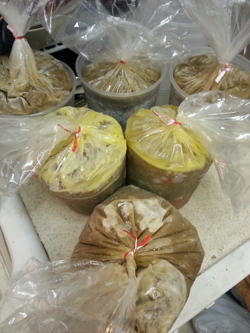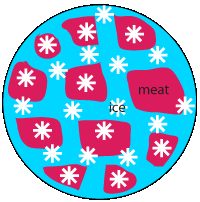Last weekend, my cousin Linda and I went to visit my good friends Mai and Roger who were introduced to me by another good friend Yuh-line, for a fun ski and snowboarding trip out in Mt. Baker. One of the treats was getting to hang out with all the kids and reliving a bunch of childhood memories for the first time, like sledding down some wicked runs and jumps that Roger and Lester (the engineers of the group) had built.
At the end of the day, I always chuckled as I watched all the deliciously adorable kids coming in from the cold after a long hard day of play, all out of breath, exhausted, and with rosy cheeks. Of course, this reminded me of one of my FWP dilemmas and a quick way to prevent it.
As you know, I like to cook in bulk and one of the problems that comes with it (especially being single) is how to store all of the leftover food. Of course, the obvious solution is to freeze it all for a later meal. What you see to the right, is the result of a bit of binge cooking which resulted in 5 gallons of two different types of soup (lentil, and chicken soups in case you were wondering!). The problem is if I cook too many large meals back to back, I get the ability to rotate and have some variety in my follow up meals, but sometimes this also means leftovers can sit in the freezer a little longer than I’d like.
This may ultimately lead to freezer burn. No bueno.
Why are these soups all bagged up you ask? Read on!
Don’t Get Burned!
Fear not, there is a simple way to prevent it without spending ridiculous amounts of money on contraptions, supplies, gadgets, and all sorts of other whizzbangdohickies. But it will require one extra step on your part:
- Package your food appropriately, preferably in a form-fitting container. If I am using a rigid container, I will typically line it with an oversize baggie – doesn’t have to be a Ziploc (I use Hefty and CVS brand baggies), just one that’s a decent quality.
- Fill your container with the food you’re storing away, and expel as much air as possible (from inside the container) and store away in the freezer. This is why a form-fitting container or bag is helpful especially with something oddly shaped like perhaps a steak or piece of chicken, though this is usually my strategy for soup.
- Coat the top or whatever remaining surfaces remain with a thin layer of oil once the food is frozen. This will act as a natural barrier preventing water from escaping, and air from coming in contact with the food. Use one that is appropriate. For most brothy, western soups, I use olive oil. Asian soups, probably sesame oil. Foods, e.g. chicken, steak, etc. will vary depending on what I want to do with it, but butter and again olive or canola oil are good options. Remember though, that butter is a fat so you will still have to prevent contact with air or risk oxidization. I press plastic wrap against it squeezing out the air prior to the deep freeze.
This should prevent or at least stave off freezer burn quite nicely for a while. If you think the oil you use will affect the flavor too much, simply rinse or wipe it off prior to reconstituting your food.
What is Freezer Burn?
When you step out into excruciatingly bitter cold weather, the cold dry air “burns” your skin  quickly by also drying it out, and basically freezing it. The cause of freezer burn is similar. When you store something in the freezer, exposing it (meats, soups, whatever) to the cold air either in or outside whatever container you’re using removes the water from your food. This is a problem because that water belongs inside your food, not outside or on top of it.
quickly by also drying it out, and basically freezing it. The cause of freezer burn is similar. When you store something in the freezer, exposing it (meats, soups, whatever) to the cold air either in or outside whatever container you’re using removes the water from your food. This is a problem because that water belongs inside your food, not outside or on top of it.
In the most extreme cases where the packaging is not airtight, and the temperature of the freezer is cold, but not cold enough to freeze the food quickly, the water in foods are extracted either completely or freezes on the surface as large ice crystals. Additionally, with the exposure to air, fats and proteins can be oxidized causing that off putting “freezer” taste. All-in-all, this causes your frozen liquids like soup to taste rancid or stale, and your meats to have a similar taste and have a soggy, spongy texture.
Prevention
As you would with your skin with the help of some ointment, simply introducing a thin water-retaining barrier between your food and the freezing air will help prevent freezer burn. This is where the thin layer of oil comes in. Air tight containers are also great, but you have to remember to fill them to the top so that there is no air actually inside the container as well. Investing in a vacuum sealer which will also let you do sous vide is also great, but most of us won’t be cooking that way often, don’t have the money to invest in the equipment or supplies, and also, if you’re like me single, and in the city, don’t have the space for it. Making sure your freezer is very cold also helps, as it promotes very quick freezing of water molecules thus ensuring that they are very small. Large crystals destroy tissue, and rupture cells causing the texture of the food you’re storing to be ruined at a molecular and cellular level.
Again, the best, simplest low-tech (always a fan), solution is to use an airtight container with all the air removed, or a baggie which will hug your food, with a little oil on top to keep the air out, and water in, and that will help ensure that the freezer won’t ruin any more of those precious steaks, soups, or anything else that will be turned into delicious leftovers!

4 comments for “Preventing Freezer Burn”